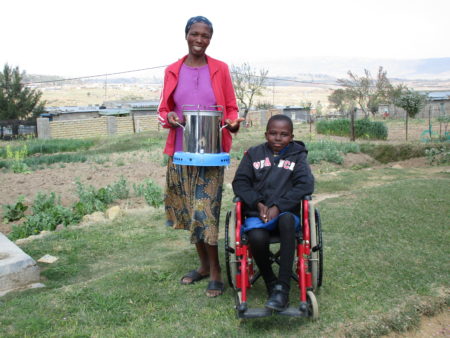
This summer, one of my foundation clients kindly asked that I offset my air travel carbon for one of our working meetings by donating to Clean Africa Energy and the Lesotho Orphans Project. So I did (a small amount, nothing earth shattering), and promptly forgot about it as I re-wrapped myself in work. Business as usual.
Yesterday I got an email from the Project (of which, under extreme duress, I have to confess that I would have honestly not even remembered), not only with the ages, name and circumstances of the recipients benefiting from the humble stove I purchased, but also with a picture and a link to the whole database of villagers that also received stoves under the current cycle (the “Donation Gallery”), each entry with a brief narrative, context as to size of the family, circumstances of their hardship and so on. That, is evidence of both SCALE and meticulous documentation. For extra points: smiling orphans holding stoves, each donor’s name in print AND the ability to download your picture so you can brag to your friends and post on Instagram? Yes please!
Did it make me feel good? You bet. Which is neither here nor there really, as my feelings are not what matters to others. I review grant outcomes each week so reading the actual report was nothing new. The kicker was documenting it like that for very small donors (of which in this context, I was). It made me feel connected, it contextualized my gift, it made my action (as forgotten as it was) meaningful.
For all intents and purposes, this is a case study. I worked for years with Next Gen boards of family foundations and their chief sadness and upfront complaint is that they never know exactly what happens with their small gifts. Thus, the organization they give too misses out on opening the door to grants from the foundations. And that’s kinda the point I am trying to make: you don’t know if somebody who just sent you a $250 check is a ridiculously generous soul that scraped pennies for a year to make this one-time gift, or if they are a millionaire.
Agencies allocate expensive staff time to do such vignettes for large gifts because it’s both good practice and often required. Few do it for the small dollars because it is too costly in manpower; but if you set up a system, you can quickly create real-time evidence of impact, build a fresh pipeline of social media content, and carve a continuous engagement pathway for small individual donors.
Clean Africa Energy clearly (pun intended) has a set process where each client gets face time + a snapshot opportunity. The fact that the stoves have different colors makes you both wonder why, and breathe with relief because let’s face it, I ain’t going to fly to Lesotho this week to double check that all that funding didn’t purchase just one stove that got passed around to people for group shots.
Too cynical? Maybe the Romanian in me is showing. Maybe after so many years doing this work I should be more cynical. Somehow, I am confirming that I am not – it chocked me up to see the smiling faces of M’e Malebohang Makone and her niece, Lerato Mokone…
Why? Because in a different life, in a different universe, that picture could have shown me and my niece. And that is the goal of a kicka$$ outcome report – to transport the donor in the shoes of someone else.
Please do this for your donors. Receiving someone’s gratitude is a gift as big as the object of gratitude itself. Also, it will put an extra smile on the face of your recipient too because let’s face it, it is lovely to be able to say “thank you”directly. And if you are in a field where you can’t show faces or names, take pictures with everyone facing away from the camera and have them all wear t-shirts that say “thank you”on the back. You’ll get giggles all-around plus extra points for creativity. I am joking, of course; just find a way to close the loop, and see your revenue streams and client/donor engagement pathways go up in the process.
Just saying!

Leave a reply